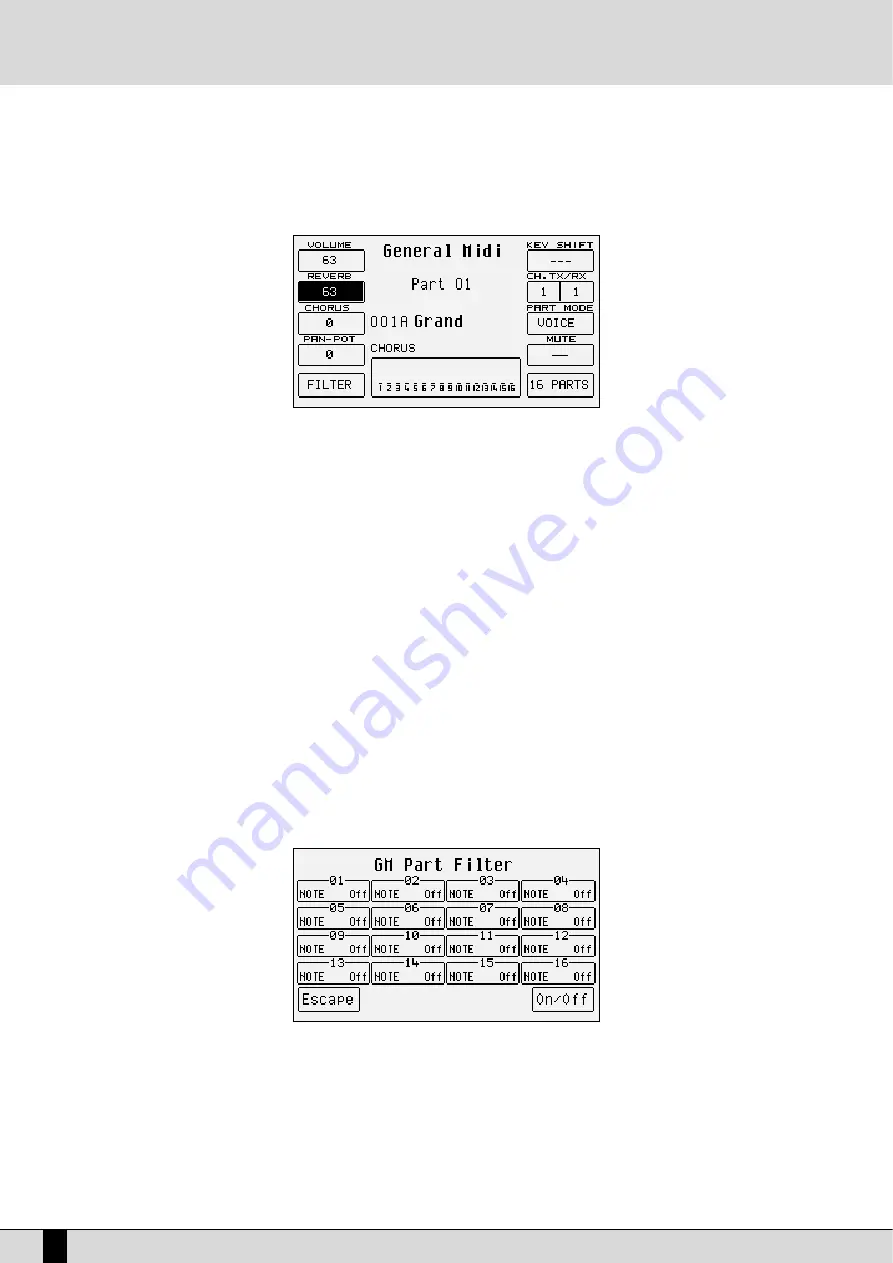
Note:
It is not necessary to continue playing the Midi file once the parameters have been loaded in the memory, however by modifying the
parameters while the Midi file is playing, it will be much easier to play back the result.
MODIFYING A SINGLE PART OF A MIDI FILE
Once a Midi file has been loaded, enable
SONG PLAY
and from the main page press
F1 GM Part
to call up the page dedicated to the parame-
ters of a single track of the Midi file. The Part is shown in the middle of the display, the parameters which can be modified are associated with
the function push buttons. Right underneath is the voice assigned to the Part and the effect used. The bottom part of the display is dedicated
to monitoring the activities of the sixteen Parts, while playing the Midi file and can be useful when locating a Part to be modified.
To move around between the single Parts use the
PAGE +/-
push buttons.
The parameters that can be modified must be selected using the dedicated function push button before the value can be modified.
Timbre:
Each track can use a voice taken from the Voice, User Voice and RAM/Flash bank. To modify the voice assigned, follow the normal pro-
cedure using the
VOICES, USER VOICE, PAGE +/-
push buttons and the function push buttons.
Modulation effect:
For each single track you can choose the modulation effect to be applied to the voice between Chorus, Distorsor and Delay,
using the
/-
push buttons. The effect entity can be programmed using
F3 Chorus/Distorsor/Delay
.
F1 Volume:
This modifies the volume of the whole track. The value can be changed using the
VALUE +/-
push buttons which, if
pressed together at the same time, reset the value.
F2 Reverb:
This modifies the Reverb entity applied to the track. The value can be changed using the
VALUE +/-
push buttons
which, if pressed together at the same time, reset the value.
F3 Chorus/Distorsor/Delay:
This modifies the entity of the modulation effect chosen between Chorus, Distorsor and Delay assigned to the track using
the
/-
push buttons. The value can be changed using the
VALUE +/-
push buttons which, if pressed together
at the same time, reset the value. The display shows the type of effect chosen next to
F3
and also below the voice.
F4 Panpot:
This modifies the arrangement of the voice on the stereo panorama. The value can be changed using the
VALUE +/-
push buttons which, if pressed together at the same time, take the voice back to the middle of the stereo panorama
(I.e. equal volume levels on both speakers).
F5 Filter:
This calls up the page where some MIDI events can be muted from the playback of the track. For example, the user
may wishes to avoid using the Modulation or some other MIDI parameter that directly affects the voice. The MIDI fil-
ters can also be used to better control an external MIDI module. The page called up from
F5 Filter
shows a table of
four lines and four columns relative to the sixteen Parts. To be able to access the MIDI filter of a single Part use the
F1
and
F6
push buttons for Parts 1, 2, 3 and 4 that are to be selected by pressing the same push buttons repeatedly.
Use push buttons
F2
and
F7
for Parts 5, 6, 7, and 8.
Use push buttons
F3
and
F8
for Parts 9, 10, 11 and 12 and push buttons
F4
and
F9
for Parts 13, 14, 15 and 16. Once the
Part to which the MIDI filter is to be applied has been found, select which MIDI message is not to be carried during
playback using the
VALUE +/-
push buttons and enable the filter using the
F10
On/Off push button. The filter is
enabled when “ON” appears next the MIDI message to be filtered.
VEGA
52
Song Play, Midi files and Karaoke
Summary of Contents for Ketron
Page 1: ...Owner s Manual I n g l e s e VEGA VEGA VEGA...
Page 3: ......
Page 94: ...Technical Tables...
Page 95: ......
Page 97: ......
Page 117: ...VEGA 116...
Page 118: ...VEGA 117 Notes...
Page 119: ...VEGA 118 Notes...
Page 120: ...VEGA 119 Notes...
Page 121: ...VEGA 120 Stampa FLAMINI srl Osimo AN 12 2002...






























